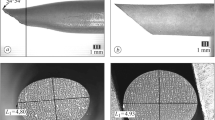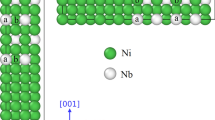Abstract
Modern complexly alloyed high-temperature nickel-base alloys contain up to 14 alloying elements. The complex composition ensures fulfillment of strict and often contradictory requirements imposed on the materials of critical parts of gas turbine engines (GTE). However, multi-component alloying creates considerable difficulties in the development of new compositions with specified characteristics or in the optimization of existing alloys. The present work is devoted to calculating the high-temperature strength of nickel alloys by means of the system of nonpolarized ionic radii (SNIR).
Similar content being viewed by others
References
C. Sims,High-Temperature Alloys [Russian translation], Metallurgiya, Moscow (1976).
V. T. Zhadan, V. A. Osadchii, and Yu. V. Yatsko, “Mathematical model of highly alloyed high-temperature nickel-base alloys,”Izv, Vuzov, Chernaya Metallurgiya, No. 2, 140 (1987).
Yu. I. Zvezdin. Yu. V, Kotov. É. L. Kats, et al., “Development of high-temperature corrosion-resistant alloys and regimes of heat treatment for hot parts of stationary gas turbines,”Metalloved. Term. Obrab. Met., No. 6, 20–22 (1991).
I. R. Woodyatt, S. T. Sims, and H. J.-J. Beattle, “Prediction of sigma-type phase occurrence from compositions in austenitic superalloys,”Trans. Met. Soc. AIME,236, 519–534 (1966).
Doyama Masao, “Computer applications to materials science and engineering,”JAERI-M,207(92), 592–597 (1992).
G. I. Morozova, “Balanced alloying of high-temperature nickel alloys,”Metally, No. 1, 38–41 (1993).
G. I. Morozova, “The phenomenon of γ′-phase in high-temperature nickel alloys,”Dokl. Ross. Akad Nauk, No. 6, 1193–1197 (1992).
É. V. Prikhod'ko,Metal Chemistry of Complex Alloys [in Russian], Metallurgiya, Moscow (1983).
System of Nonpolarized Ionic Radii and Its Use for the Analysis of the Electron Structure and Properties of Substances [in Russian], Naukova Dumka, Kiev (1973).
É. V. Prikhod'ko, “Physicochemical modeling of structure formation and properties of high-temperature steels and alloys,” in:High-Temperature and Heat-Resistant Steels and Nickel-Base Alloys [in Russian], Nauka, Moscow (1984), pp. 4–11.
A. A. Bondarev, A. B. Bondarev, and T. M. Kunyavskaya, “To the problem of choosing regimes for deformation heat treatment of high-temperature nickel alloys,”Metalloved. Term. Obrab. Met., No. 10. 34–38 (1989).
Author information
Authors and Affiliations
Additional information
Translated from Metallovedenie i Terrilicheskaya Obrabotka Metallov, No. 6, pp. 9–11, June, 1995.
Rights and permissions
About this article
Cite this article
Ovsepyan, S.V., Lomberg, B.S. & Baburina, E.V. Calculation of the high-temperature strength of complexly alloyed nickel alloys using equations of the system of nonpolarized ionic radii. Met Sci Heat Treat 37, 226–228 (1995). https://doi.org/10.1007/BF01152223
Issue Date:
DOI: https://doi.org/10.1007/BF01152223




